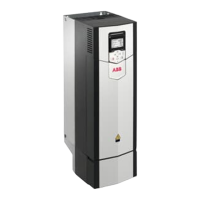What to doCause
Event name /
Aux. code
Code
(hex)
highest temperature was measured.
“ZZ” specifies the phase (0: single
module, 1: U-phase [parallel
connection], 2: V-phase [parallel
connection], 3: W-phase [parallel
connection]).
Check ambient conditions.Drive IGBT temperature is excessive.IGBT
temperature
A4F6
Check air flow and fan operation.
Check heatsink fins for dust pick-up.
Check motor power against drive
power.
Check the connections between the
drive control unit and the power unit.
Communication errors detected
between the drive control unit and the
power unit.
PU
communication
A580
Check the auxiliary code (format XXXY
YYZZ). With parallel-connected
modules, “Y YY” specifies the affected
BCU control unit channel (0:
broadcast). “ZZ” specifies the error
source (8: Transmission errors in PSL
link [see “XXX”], 9: Transmitter FIFO
warning limit hit). “XXX” specifies the
transmission error direction and
detailed warning code (0:
Rx/communication error, 1:
Tx/Reed-Solomon symbol error, 2:
Tx/no synchronization error, 3:
Tx/Reed-Solomon decoder failures, 4:
Tx/Manchester coding errors).
Read the PSL2 data log. In Drive
Composer pro, check the time stamp
of the A580 fault. Load the log with
the same date and time. When the file
opens, click “Show fault log”.
Check the power unit hardware.
Check the setting of parameter 95.20
HW options word 1, bit 14.
Cooling fan feedback missing.FanA581
Check the auxiliary code to identify
the fan. Code 0 denotes main fan 1.
Other codes (format XYZ): “X”
specifies state code (1: ID run, 2:
normal). “Y” specifies the index of the
inverter module connected to BCU
(0…n, always 0 for ZCU control units).
“Z” specifies the index of the fan (1:
Main fan 1, 2: Main fan 2, 3: Main fan
3).
Note that modules are coded starting
from 0. For example, the code 101
means that Main fan 1 of module 1
(connected to BCU channel V1T/V1R)
has faulted during its ID run.
Check fan operation and connection.
Replace fan if faulty.
Fault tracing 573

